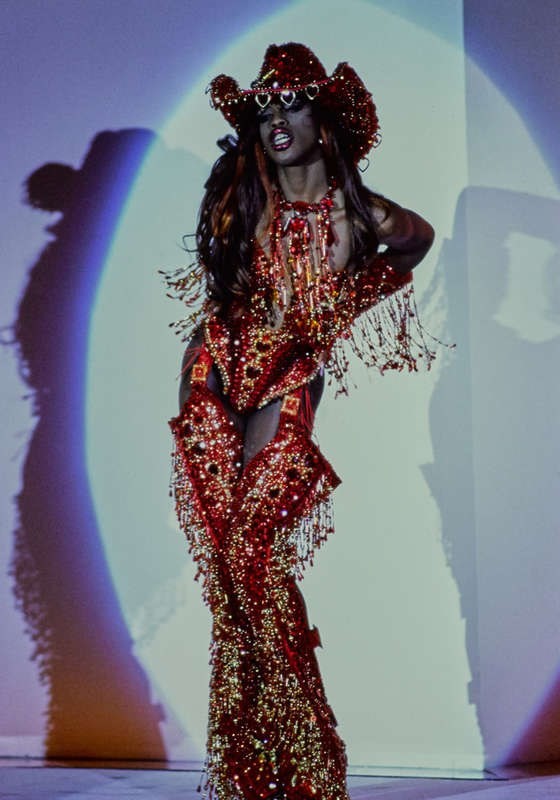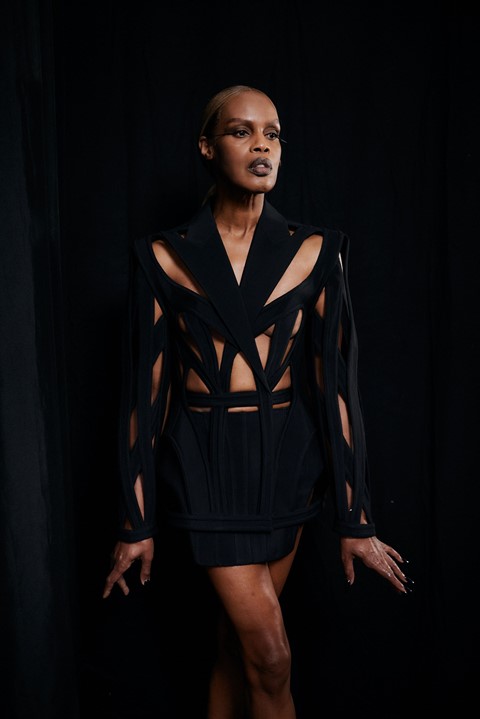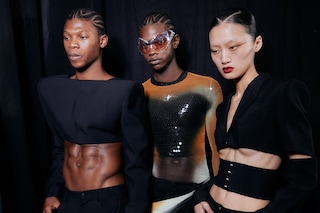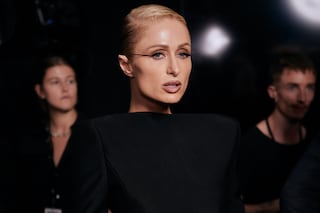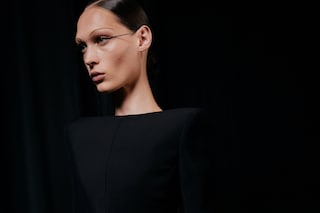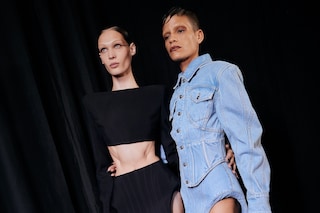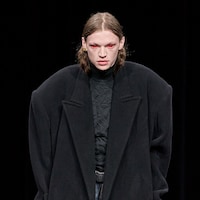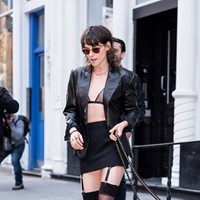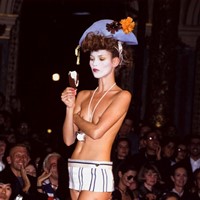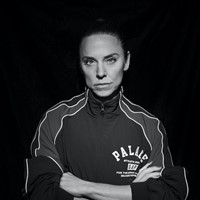After an iconic return to the Paris runway at Casey Cadwallader’s SS24 show, the legendary model remembers the moment she first met Thierry and discusses trans representation and dream castings
The word ‘icon’ is bandied about freely, it does a disservice to those actually deserving of this mantle. When it comes to model and pioneer Connie Fleming – AKA Connie Girl – she truly embodies every sense of the word.
As an OG Thierry Mugler muse, you’ll most likely recognise her from the designer’s SS92 show, Les Cowboys, somehow managing to steal the spotlight from heavyweights like Yasmeen Ghauri, Eva Herzigova, and Naomi Campbell as she sashayed down the catwalk in a red cowgirl get-up, bedazzled within an inch of its life.
A trailblazer for the trans community, Connie Girl made her debut years before Lea T and Andreja Pejić, later followed by the newer generation of trans models: Hari Nef, Alex Consani, Teddy Quinlivan, and Colin Jones. Her undeniable beauty – cherubic face and Barbie body – made her an obvious choice for runway appearances elsewhere at Vivienne Westwood and Andre Walker.
More recently, after star turns on the runway at AREA and a Candy cover cosplaying as Michelle Obama, the Mugler muse was welcomed home in March by current creative director Casey Cadwallader for the Mugler H&M collaboration. Appearing as part of an all-star cast alongside Arca, Mariacarla Boscono, and the Jerry Hall, it was an amuse-bouche for a moment 30 years in the making, for Connie Girl to burn down a Mugler runway once more.
With Cadwallader bringing the house back to the PFW schedule for SS24, what better way to celebrate than with an archive-honouring collection worn by some familiar faces, including cameos from Angela Bassett, Helena Christensen, and Paris Hilton [sliving!]
With a full comeback seemingly on the cards, we caught up with the fashion icon to talk about being a Mugler muse, trans representation, and how Casey Cadwallader is carrying on Manfred Thierry Mugler’s legacy.
Hey Connie Girl! Tell me, how it feels to be dipping your toes back into modelling?
Connie Girl: Scary and wonderful. It was a real testament to Manfred and his legacy for Casey to bring back the old cows out of the pasture.
I would say icons, not old cows!
Connie Girl: It was so beautiful and it honoured Manfred in such a wonderful way. His vision of inclusivity, agelessness, body image – all of the things he stood for which are now en vogue. Along with Gaultier and several other designers, Manfred pioneered this back in the day. So, to see Casey and Mugler take from that and expand it was beautiful and incredible to be part of it.
It was fantastic to be part of a cast that was all sizes, colours, ages. It was good for the soul in a way and got me to sit up a little straighter and pick up my chin. To be a part of a legacy in a moment where you’re not worrying about making your rent or buying food, you can think about it on a deeper level and I really got a moment of being able to do that.
How did it all come about?
Connie Girl: We spoke before when they were doing the films during COVID, but my passport had expired so I couldn’t do the first one and then the second time didn’t work out either. On the night of the opening of Thierry Mugler: Couturissime at the Brooklyn Museum, I saw Casey with Kylie Jenner. I’m a runway coach with New York Model Management and one of the bookers is really great friends with Haley Wollens. We were marvelling at the show and the booker said: ‘Haley is in love with you and wants to meet you’ so we met and took some pictures together and she told me that her and Casey wanted to work with me. Then, a couple of months later they called me for the Mugler H&M explosion.
“Casey has started a new Mugler language that has expanded on the old and transformed into something new. The last collection was an incredible triumph for him, taking the essence of Mugler and expanding into something visionary” – Connie Girl
The campaign image of you together is the moment.
Connie Girl: It’s incredible. I got to walk with Jerry Hall and her hair. I didn’t want to fangirl, but I’m an illustrator and Antonio Lopez is one of my heroes of fashion illustration so I bit my tongue and tried not to ask her incessant questions about him, but we spoke on set. She’s incredibly funny and giving. Watching her, I started to see things that I thought were the brushstroke of Antonio, but it’s her and the way she carries herself, her aura. That was such an incredible gift added on to being included in this wonderful project. The high-low philosophy of spreading the Mugler vision.
The way you described meeting Haley and hearing Casey was a fan of yours is similar to how you started modelling for Mugler. What do you remember about first meeting Manfred?
Connie Girl: Everybody was telling him about this new Black girl in New York. I think maybe two seasons before, I sent some pictures but they weren’t the best. At that point, I’d just done small stuff and the pictures weren’t great so they passed. Then on the night of Susanne Bartsch’s first Love Ball, I go downstairs with my friend and roommate and run smack into Manfred. He looked at me and said: ‘Oh you’re the one that they’re all talking about.’ Then a couple of months later I was on my way to Paris.
We need to talk about the SS92 Les Cowboys outfit. I don’t know if you know this, but Mistress Isabelle Brooks just wore a recreation of it on the most recent season of RuPaul’s Drag Race!
Connie Girl: Somebody sent it to me on Instagram, it was so awesome, I was blown away. You wear something at a show and then you think it’s gone, but that look has lived its own life and it’s an incredible testament to Mr Pearl the master corset maker and Manfred’s vision of Americana.
It’s probably my all-time favourite Mugler outfit. What was your experience of wearing it at the show? The crowd erupts as you sashay out in it.
Connie Girl: The crowd was erupting all throughout that show because it also had the motorcycle bustier, Ivana Trump was in that show, the chandelier bustier got a huge applause. You would be backstage changing and would hear the eruption and try to peek out to see who it was. Diane Brills Mae West look! That was a Mugler show, it was a true spectacle. Diana Ross was a secret and then they started playing her music and you heard a roar. I was changing and when I came around the corner, I was face to face with her, it was insane. The shows were so theatrical and they had crescendos. We’d be screaming backstage too.
What was your relationship like with Manfred and how did it develop over the years you were working together?
Connie Girl: During those years he adopted New York and the downtown as his second home. He had this community in the creative nightclub scene who were a respite from the grind of being a successful designer and gave him so much love and joy. Back then, you did have relationships with designers and would hang out and socialise and they would take in your style and personality and have that in mind when they’d go to design. This is for Connie, this is for Emma [Sjöberg/Wiklund], this is for Diane Bill, this is for Stella [Ellis]. To have a source like Mr Pearl to sculpt, the imagination could really soar. It was a wonderful time, but I look back on it with a little bit of sadness because he isn’t here. I’ll always be thankful to be part of it and that I had a relationship with a wonderful artist and creative.
Did it feel like you were making history as you these events were unfolding?
Connie Girl: In spots here and there. Doing “Too Funky” because it was during the time of the plague and we were all bruised and on autopilot. Our reason for going on was to fundraise and spread the word, not to let the hateful rhetoric engulf those who were weakened. We had this do or die attitude that it wasn’t going to go down like that and we were not going to be eradicated or have a false narrative put out there. You did feel those historic moments, but it was veiled by the immediacy of the task at hand. We were trying to keep our heads above water and make beauty at the same time.
Representation and inclusivity in fashion have become big talking points today, but what were your thoughts on it while you were modelling?
Connie Girl: I don’t think I thought of it in that way, I just wanted to do a good job so that whoever came after me wouldn’t have to fight the battles that I did. I didn’t see it as standing up or making a statement, I was happy. I was almost through with my transition and I was so happy to feel that I wasn’t evil or crazy or a stain on the world. As a trans woman of colour, I wasn’t going to be dismissed or watered down. I had seen so many trans girls in the industry be eradicated and erased and I was happy in my transition so I didn’t feel like I should hide it. If that was representation, then I’ll take it.
“On the night of Susanne Bartsch’s first Love Ball, I go downstairs with my friend and roommate and run smack into Manfred. He looked at me and said: ‘Oh you’re the one that they’re all talking about.’ Then a couple of months later I was on my way to Paris” – Connie Girl
What were attitudes like then towards trans models?
Connie Girl: Misgendering, making comments, and pitting you against other people in the press. At the time of the cowgirl look, there was a boxer in France who had just won a prize and they asked him about me and were egging him on to see if he thought I was pretty. As a straight athlete, he had to take it to violence and made threats if he ever saw me. That kind of stuff was accepted and there were very few avenues to fight it. When you did, you were labelled as difficult. Another way there was erasure was saying that you were trying to fool people or that it was a detriment to regular models by degrading them. It was that divisive and it wasn’t an undercurrent, it was in your face and accepted so you just had to push on.
You’re also a runway coach now, how have you seen diversity change over the years?
Connie Girl: Ten years ago, I was teaching at an agency and the booker told me there was a trans girl. I had to hold my breath because it was so beautiful. I taught the lesson, walked downstairs, and by the time I reached the sidewalk I was in tears because it was such a wonderful thing that there was room being made for a community that is part of fashion.
Now that you’ve made your runway comeback for Mugler, what other brands are on your bucket list?
Connie Girl: A Chanel moment would be nice. Rick Owens. A Christian Siriano moment would be lovely. A Gaultier moment would be wonderful. Valentino. Those are the start of the bucket list and it’s growing.
Earlier, you said you wanted to honour Casey and his chapter at Mugler. How do you think his vision is representative of the house’s values?
Connie Girl: It’s like when Galliano started at Dior, wiping the slate clean and starting a new language. Casey has started a new Mugler language that has expanded on the old and transformed into something new. The last collection was an incredible triumph for him, taking the essence of Mugler and expanding into something visionary. I was so happy for him and there were points backstage where I had to collect myself and not break down because I was incredibly happy to see him take the reins and go into the future.
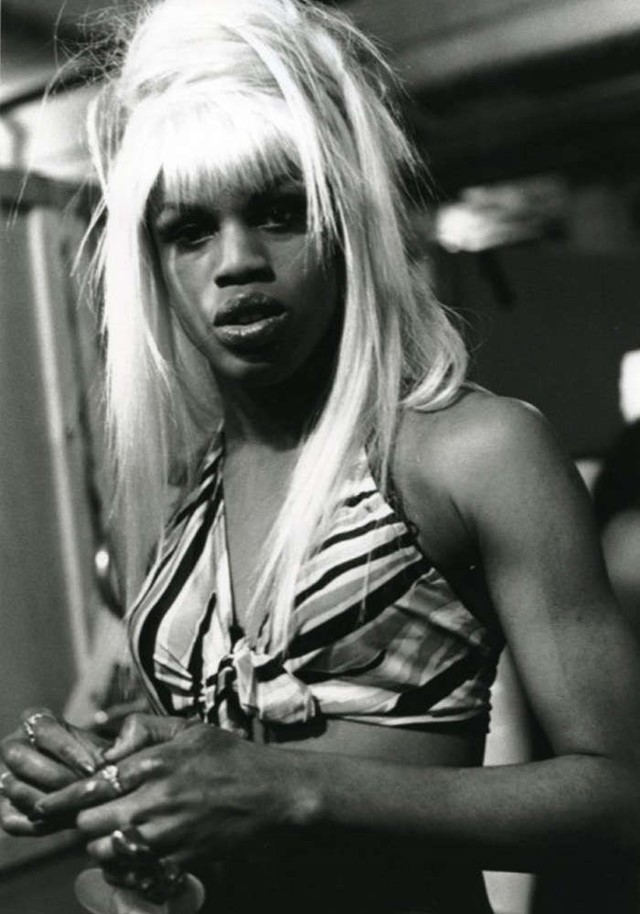
As a final question, how do you think your younger self would react to where you are in fashion now as a revered cult figure?
Connie Girl: It’s weird because at the time I was thinking, ‘I have to make my rent’ and just wanted to be able to live in this world and push forward for my sisters and brothers. I wanted to do good so that there would be a future for those who would come behind me. Back then, I would look at Iman, Grace Jones, Mounia, Amalia [Vairelli], Katoucha [Niane] and they reflected me as a young person of colour. I could see my full lips and the richness of my skin reflected back at me, so it’s incredible to be in that position now, it’s a sort of responsibility. I got to meet Tracy ‘Africa’ Norman recently and it was just so beautiful. I didn’t know enough about her story and I wish I did because it would have informed me so much. I got a twinkle in my eye when I saw Teri Toye, but Teri Toye did not reflect me and Tracy would have. I would have been able to say this is possible and not an unattainable dream. I hope that I am a conduit for dreams. It’s frightening, but an honour.
